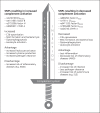Common Genetic Variants in the Complement System and their Potential Link with Disease Susceptibility and Outcome of Invasive Bacterial Infection
- PMID: 31269507
- PMCID: PMC7098274
- DOI: 10.1159/000500545
Common Genetic Variants in the Complement System and their Potential Link with Disease Susceptibility and Outcome of Invasive Bacterial Infection
Abstract
Streptococcus pneumoniae and Neisseria meningitidis are pathogens that frequently colonize the nasopharynx in an asymptomatic manner but are also a cause of invasive bacterial infections mainly in young children. The complement system plays a crucial role in humoral immunity, complementing the ability of antibodies to clear microbes, thereby protecting the host against bacterial infections, including S. pneumoniae and N. meningitidis. While it is widely accepted that complement deficiencies due to rare genetic variants increase the risk for invasive bacterial infection, not much is known about the common genetic variants in the complement system in relation to disease susceptibility. In this review, we provide an overview of the effects of common genetic variants on complement activation and on complement-mediated inflammation.
Keywords: Common genetic variants; Complement system; Disease susceptibility; Inflammation; Single nucleotide polymorphisms; Streptococcus pneumoniae.
© 2019 The Author(s) Published by S. Karger AG, Basel.
Conflict of interest statement
The authors have no conflicts of interest to declare.
Figures




Similar articles
-
Interactions between Neisseria meningitidis and the complement system.Trends Microbiol. 2007 May;15(5):233-40. doi: 10.1016/j.tim.2007.03.005. Epub 2007 Mar 29. Trends Microbiol. 2007. PMID: 17398100 Review.
-
Protective potency of recombinant meningococcal IgA1 protease and its structural derivatives upon animal invasion with meningococcal and pneumococcal infections.Microbes Infect. 2019 Aug-Sep;21(7):336-340. doi: 10.1016/j.micinf.2019.02.003. Epub 2019 Feb 22. Microbes Infect. 2019. PMID: 30797878
-
Human genetics of meningococcal infections.Hum Genet. 2020 Jun;139(6-7):961-980. doi: 10.1007/s00439-020-02128-4. Epub 2020 Feb 17. Hum Genet. 2020. PMID: 32067109 Free PMC article. Review.
-
Mechanisms in Neisseria meningitidis for resistance against complement-mediated killing.Vaccine. 2008 Dec 30;26 Suppl 8(6):I34-9. doi: 10.1016/j.vaccine.2008.11.059. Vaccine. 2008. PMID: 19388162 Free PMC article. Review.
-
Infections of people with complement deficiencies and patients who have undergone splenectomy.Clin Microbiol Rev. 2010 Oct;23(4):740-80. doi: 10.1128/CMR.00048-09. Clin Microbiol Rev. 2010. PMID: 20930072 Free PMC article. Review.
Cited by
-
Characterization of the innate immune response to Streptococcus pneumoniae infection in zebrafish.PLoS Genet. 2023 Jan 9;19(1):e1010586. doi: 10.1371/journal.pgen.1010586. eCollection 2023 Jan. PLoS Genet. 2023. PMID: 36622851 Free PMC article.
-
Therapeutic strategies targeting complement in myasthenia gravis patients.J Neurol. 2025 Jul 2;272(8):489. doi: 10.1007/s00415-025-13225-7. J Neurol. 2025. PMID: 40601074 Free PMC article. Review.
-
Plasma proteomic profiling of bacterial cold water disease-resistant and -susceptible rainbow trout lines and biomarker discovery.Front Immunol. 2023 Oct 20;14:1265386. doi: 10.3389/fimmu.2023.1265386. eCollection 2023. Front Immunol. 2023. PMID: 37928534 Free PMC article.
-
Mast Cells and More.J Innate Immun. 2021;13(3):129-130. doi: 10.1159/000516180. Epub 2021 Apr 22. J Innate Immun. 2021. PMID: 33887720 Free PMC article. No abstract available.
-
C1q Gene Polymorphism Is Associated with Asymptomatic Bacteriuria in Patients with Type 2 Diabetes Mellitus.Medicina (Kaunas). 2022 May 31;58(6):750. doi: 10.3390/medicina58060750. Medicina (Kaunas). 2022. PMID: 35744013 Free PMC article.
References
Publication types
MeSH terms
Substances
LinkOut - more resources
Full Text Sources
Medical

